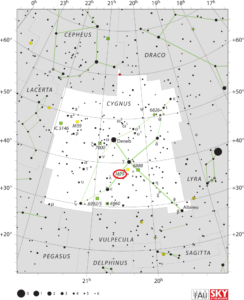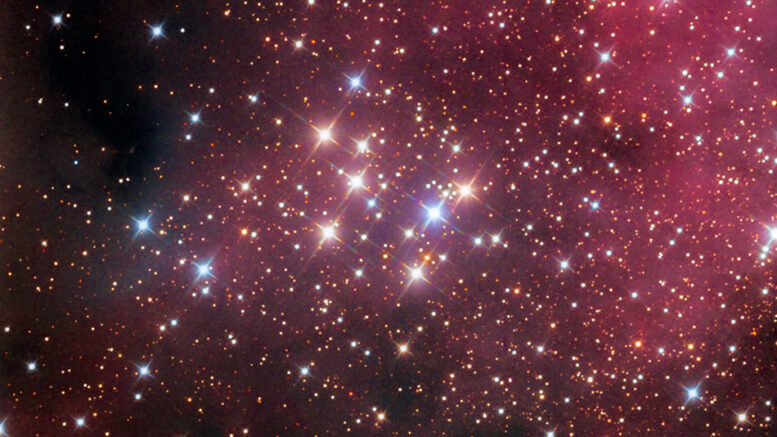Messier 29 is relatively small, occupying an area of 7 arc minutes in the sky, or a quarter the size of the full Moon. However, without the dust of the Milky Way obscuring the cluster, the stars in M29 would appear about 1,000 times brighter. This is because the cluster’s light is blocked by the material that was around when the stars were still forming.
| Description | |
| Visible From Pacific Northwest | April to November |
| Best Time To Observe | June, July, and August |
| Minimum Size Of Viewing Device | Binoculars |
| Object Type | Open Cluster |
| Designations | Messier 29, M29, NGC 6913, OCl 168, Collinder 422, MWSC 3329, C 2022+383, h 2078 |
| Right Ascension | 20h 23m 56s |
| Declination | +38°31.4′ |
| Constellation | Cygnus |
| Number Of Stars | 50 |
| Apparent magnitude | 7.1 |
| Apparent dimensions | 7′ |
| Object Radius | 5.5 light years |
| Distance From Earth | 4,000 light years |
History
This object is an original discovery of Charles Messier, who first observed it in 1764. As he wrote of the object in his notes at the time:
“In the night of July 29 to 30, 1764, I have discovered a cluster of six or seven very small stars which are below Gamma Cygni, and which one sees with an ordinary refractor of 3 feet and a half in the form of a nebula. I have compared this cluster with the star Gamma, and I have determined its position in right ascension as 303d 54′ 29″, and its declination of 37d 11′ 57″ north.“
Locating M29 In The Sky
Messier 29 is located in the vicinity of the bright supergiant star Sadr, Gamma Cygni, which marks the intersection of the Northern Cross, a familiar asterism in the summer sky. With a visual magnitude of 2.23, Sadr is the second brightest star in Deneb. M29 can be found 1.7 degrees to the south and a little east of Sadr. It lies in a rich, crowded region of the Milky Way.

Viewing M29
Messier 29 is too faint to be spotted by the naked eye, but can be seen in binoculars. It is best observed in telescopes at the lowest powers. M29 is visible in binoculars but best seen at low to medium powers through telescopes. When viewed through an 80mm (3.1-inch) scope, the stubby big dipper shape of the main stars is clearly visible. Through larger scopes, M29 appears much the same although more members are visible along with many non-cluster stars. In the vicinity of M29, there is some diffuse nebulosity, which can be detected in images and photographs.
Photographing M29
There are not many sites that provide great references for those who wish to image M29. However, there are a few great recommendations to get a sense of what can be done including a CloudyNights Forum Post and Astropixels that can help provide some additional clarification. Autoguiding is a must here too make sure that the image is crisp.
Sources And Further Reading
Descriptions of all of Messier Objects can be found here.
https://freestarcharts.com/messier-29

Be the first to comment on "Messier 29"